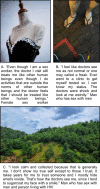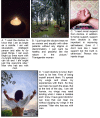"I want the doctors to know that I am as bright as a candle": : Experiences with and Hopes for Doctor Interactions Among Malaysian Key Populations and People Living with HIV
- PMID: 36472685
- PMCID: PMC9734400
- DOI: 10.1007/s10461-022-03942-9
"I want the doctors to know that I am as bright as a candle": : Experiences with and Hopes for Doctor Interactions Among Malaysian Key Populations and People Living with HIV
Abstract
Stigma in healthcare settings is a pernicious barrier to HIV prevention and treatment in contexts with strong HIV-related structural stigma. Previous work has documented substantial stigma towards key populations and people living with HIV (PLWH) among Malaysian doctors. The perspectives of Malaysian key populations and PLWH, however, remain understudied. In 2021, 34 Malaysian participants representing key populations and PLWH engaged in a photovoice study designed to qualitatively explore their experiences with and hopes for doctor interactions. Many participants reported stigma from their doctors, perceiving that doctors view them as not normal, sinful, misguided, and incapable. Several emphasized that they wear figurative masks to conceal aspects of themselves from doctors. Yet, many also remain hopeful for constructive relationships with doctors. They want their doctors to know that they are bright, capable, kind, and valuable. Interventions are needed to address stigma among doctors working in contexts with strong structural stigma.
El estigma en los ambientes de atención médica es una barrera perniciosa en la prevención y el tratamiento del VIH. Investigaciones anteriores han documentado un estigma sustancial hacia los grupos de población clave y las personas que viven con el VIH (PLWH por sus siglas en inglés) entre los médicos de Malasia. Sin embargo, las perspectivas de los grupos de población clave y las PLWH en Malasia siguen sin estudiarse. En 2021, 34 participantes que representaban los grupos de población clave y PLWH en Malasia participaron en un estudio de fotovoz diseñado para explorar cualitativamente sus experiencias y esperanzas en las interacciones con los médicos. Muchos participantes describieron el estigma de sus médicos, percibiendo que los médicos los ven como no normales, pecaminosos, equivocados e incapaces. Varios enfatizaron que usan máscaras figurativas para ocultar aspectos de ellos mismos a los médicos. Sin embargo, muchos también mantienen la esperanza de tener relaciones constructivas con los médicos. Quieren que sus médicos sepan que son inteligentes, capaces, amables y valiosos. Se necesitan intervenciones para abordar el estigma estructural entre los médicos que trabajan en la prevención y el tratamiento del VIH.
Keywords: HIV; Key Populations; Photovoice; Stigma.
© 2022. The Author(s), under exclusive licence to Springer Science+Business Media, LLC, part of Springer Nature.
Conflict of interest statement
The authors declare no conflicts of interest.
Figures
Similar articles
-
An investigation of stigmatizing attitudes towards people living with HIV/AIDS by doctors and nurses in Vientiane, Lao PDR.BMC Health Serv Res. 2017 Feb 10;17(1):125. doi: 10.1186/s12913-017-2068-8. BMC Health Serv Res. 2017. PMID: 28183300 Free PMC article.
-
Social-cultural factors of HIV-related stigma among the Chinese general population in Hong Kong.AIDS Care. 2017 Oct;29(10):1255-1259. doi: 10.1080/09540121.2017.1282601. Epub 2017 Jan 23. AIDS Care. 2017. PMID: 28110546
-
HIV stigma and disclosure experiences of people living with HIV in an urban and a rural setting.AIDS Care. 2015;27(8):1042-6. doi: 10.1080/09540121.2015.1020747. Epub 2015 Mar 19. AIDS Care. 2015. PMID: 25790237
-
[Stigma and HIV: relevant for everyone].Rev Med Suisse. 2020 Apr 15;16(690):744-748. Rev Med Suisse. 2020. PMID: 32301309 Review. French.
-
Socio-demographic, clinical and service use determinants associated with HIV related stigma among people living with HIV/AIDS: a systematic review and meta-analysis.BMC Health Serv Res. 2021 Sep 22;21(1):1004. doi: 10.1186/s12913-021-06980-6. BMC Health Serv Res. 2021. PMID: 34551772 Free PMC article.
Cited by
-
Stigma and fear of getting sick in the care of people living with HIV: an exploratory systematic review.Infez Med. 2024 Jun 1;32(2):168-182. doi: 10.53854/liim-3202-6. eCollection 2024. Infez Med. 2024. PMID: 38827831 Free PMC article. Review.
-
Capturing the HIV-related social exclusion practices experienced by key populations through photovoice: an interpretative phenomenological study.Reprod Health. 2024 Jul 15;21(1):107. doi: 10.1186/s12978-024-01832-y. Reprod Health. 2024. PMID: 39004733 Free PMC article.
-
Strengthening HIV Activism Among Clinicians in Malaysia: A Randomised Controlled Trial.AIDS Behav. 2025 Jul 21. doi: 10.1007/s10461-025-04829-1. Online ahead of print. AIDS Behav. 2025. PMID: 40691430
-
The use and operationalization of "structural stigma" in health-related research: A scoping review.BMC Public Health. 2024 Dec 30;24(1):3614. doi: 10.1186/s12889-024-21171-8. BMC Public Health. 2024. PMID: 39736593 Free PMC article.
References
-
- Major B, Dovidio JF, Link BG, Calabrese SK. Stigma and its implications for health: introduction and overview. In: Major B, Dovidio JF, Link BG, editors. The Oxford Handbook of Stigma, discrimination, and Health. New York: Oxford University Press; 2018. pp. 3–29.
-
- Hatzenbuehler ML. Structural stigma and health. In: Major B, Dovidio JF, Link BG, editors. The Oxford Handbook of Stigma, discrimination, and Health. New York: Oxford University Press; 2018. pp. 105–21.
MeSH terms
Grants and funding
LinkOut - more resources
Full Text Sources
Medical



